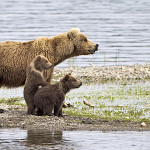
The controversial trophy hunt for at-risk grizzly bears in the province of British Columbia, Canada, re-opened this month and is now in full swing.

Scrutiny of this hunt was ramped up last year with new evidence that its economic benefits are small when compared with ecotourism. Add to this further research that suggests hunting management strategies impose considerable risks to bear populations and it’s not surprising that concerns are being raised.
There is strong opposition from many indigenous groups, which have renewed calls for the government to respect tribal laws that ban the hunt on their traditional territories.
They are not alone—recent poll data suggests that 80-90 percent of citizens in the province, including hunters who target other species, oppose the trophy hunt.
Nevertheless, despite this opposition the hunt was not only re-opened but expanded on April 1—what might have passed for an April Fools’ joke was instead presented as “science-based” management.
Protecting Against Over-Kill
But our recent study casts doubt on this “science-based” management. We found that between 2001-2011, human kills of grizzly bears (of which four out of every five were from trophy hunting) exceeded government limits in half of all hunted populations.
We also found that hunt targets were not conservative because they did not properly take into account uncertainty in bear numbers, population growth rates, or poaching rates.
This uncertainty is not surprising: counting bears accurately in their remote wilderness habitats is difficult, let alone studying how quickly they reproduce and replace lost individuals.
To address this we described a management approach that explicitly takes uncertainty into account. To keep the probability of over-kill below 5 percent, targets would need to be reduced by 80 percent, and one-third of hunted bear populations would need to be closed to hunting.
Contradictions
Surprisingly, shortly after this study was released, the government instead announced plans to increase the number of bears to be hunted and to re-open the hunt in two populations that had previously been closed because of over-kills.
Managers stated that “because we recognize inherent uncertainty in our population and harvest rate estimates, conservative mortality targets are used.” While the government used language reminiscent of the recent study, they decided to expand the hunt, contrary to its conclusions.
The minister in British Columbia responsible for managing the hunt came under fire repeatedly in the provincial legislature for this. He was also criticised for claiming in a press release that sustainability of the hunt was confirmed by another study—which was not the case.
This raises the question—are “science-based” management decisions actually guided by science?

Science-Based Management?
Scientific research and enquiry is held up for external scrutiny through the peer review process. This ensures key scientific values: transparency, rationality and reliance on rigorous evidence.
Scientists have no choice about this. If they want to publish their work in a credible journal, it needs to be peer-reviewed. Work that does not stand up to scrutiny gets rejected. But there is no such requirement for most wildlife management decisions, even those claiming to be “science-based.”
Although scientists might spend years gathering and analysing data, packaging it into a manuscript, and revising their work in light of reviews by independent experts, politicians can make “science-based”claims without any such checks.
For ‘Science-Based’ Read ‘Politics-Driven’
Not surprisingly this can and does lead to decisions guided more by politics than by science. The infamous collapse of the cod fishery in eastern Canada in the 1980s comes to mind.
And more recently, the science behind efforts to remove gray wolves from the US Endangered Species Act, and in the decision to cull badgers in the UK, has also been questioned.
A recent letter in the journal Science has pointed out this shortcoming in“science-based” wildlife management, and following the letter’s release, more stories of questionable science emerged. It seems examples of scientific shortcomings might be the rule, not the exception.
Independent Peer-Review for Wildlife Managers?
Fortunately, the well-established scientific publishing process can provide ways to improve management decisions: subjecting management decisions to the same outside scrutiny expected of scientists would be an important first step.
As well as making science management more rigorous and transparent, external peer review would have the added bonus of helping to bridge the long bemoaned science-policy gap.
——–
YOU MIGHT ALSO LIKE
Idaho Passes Bill to Kill Hundreds of Wolves
Yellowstone Announces End to 2014 Bison Slaughter Following One-Man Blockade
U.S. Wildlife Services Kills 1.5 Million Animals Each Year With No Public Accountability
——–
[source: http://ecowatch.com/2014/04/11/bc-expands-grizzly-bear-trophy-hunt/]

Leave a Reply
You must be logged in to post a comment.